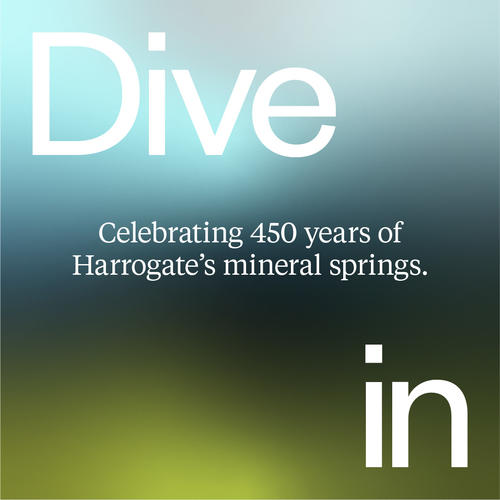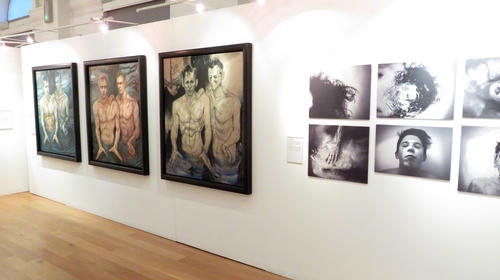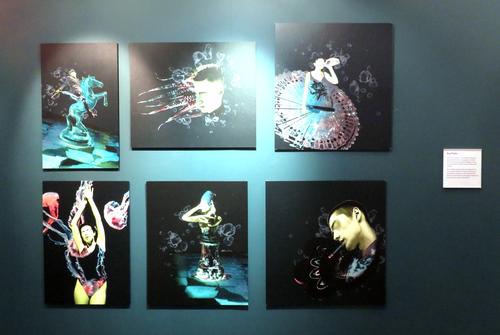Dive In
Impressions of the exhibition
Image Credit: Sarah Dillon / Astrid Köhler
Diving into underwater worlds. Art on display by Eva Prühs
Image Credit: Eva Prühs / Astrid Köhler
Dive In: celebrating 450 years of Harrogate’s mineral springs
September 18th 2021 to March 27th 2022
Plunge in to this exhibition to discover how Harrogate has been shaped by its legendary waters. Encounter images from the town’s spa history, alongside works of contemporary art that explore broader themes of water, history, health and healing.
Opening with historic views of Harrogate spa, the exhibition highlights artwork by some of Britain’s leading contemporary artists, including Caroline Walker’s paintings set in a Budapest thermal baths where public and private spaces overlap; Serena Partridge’s tiny textile works that blur fact and fiction in Harrogate’s past, and Kate Mellor’s photographs that ponder the relationship between photography, history and truth during an illusory quest through European spa towns.
The exhibition features even works by the art students of the htk academy Hamburg Josefine Buckenhauer, Sarah Dillon, Nicola Maas, Eva Prühs and Charlotte Uhlemann, which were created as part of an art project organised by The European Spa.
Mercer Art Gallery
Swan Road
Harrogate HG1 2SA
Telephone 01423 556188
Open daily 10.00 – 16.00 (please check our facebook page for updates before your visit).
**
In the autumn of 2019, a group of students of Communication design (https://www.htk.academy/), Hamburg-based artist Gaby Bergmann (https://handtoeye.de/) and researcher Henrike Schmidt from the European Spa project (https://www.theeuropeanspa.eu/) embarked on a journey through spa history and spa life, and considered the relevance of spas in today’s world. They discussed some pertinent literary works such as Thomas Mann’s novel The Magic Mountain, engaged with theory about special places of this kind such as Michel Foucault’s work on ‘Other Spaces’ or heterotopias, and they visited the historic Holthusenbad in Hamburg and the seaside resort of Travemünde.
Their readings, discussions and drawing sessions in situ gave rise to a process of creative engagement and a rich output of art works, some of which can be seen in this exhibition.
The Artists:
Nicola Maas was born and raised in the Saar region, near the French-German border, and moved to Hamburg for her studies.
In the watercolours on display, she says, she wanted to capture what it feels like, when entering the water, either to be weighed down by affect, or gradually to become free of it. What is the emotional effect of diving down and sinking into the stillness of the water? And of returning to the surface?
Sarah Dillon grew up as an outcast in a small, conservative American town, and made her escape as a young adult.
With her photos, she wants you to imagine you arecompletely submerged underwater. Eyes shut. Sounds muted. Completely alone. Do you feel peace or panic? Will the water wash it all away or drag you under?
Charlotte Uhlemann was born and grew up in Lüneburg, northern Germany. She has now graduated as a graphic designer from the htk academy in Hamburg.
With her collages she seeks to capture the atmosphere of that narrow other world one immerses oneself in for the duration of a spa stay.
Eva Prühs was born and raised in Hamburg, graduated from the htk academy in 2020, and now works as a graphic designer whilst broadening her interests as a post-graduate student.
Her collages take as their starting point the contrasting aesthetic alignment of beauty with youth and health and ugliness with sickness and decay. For Nietzsche, the two were mutually dependent – a phenomenon clearly visible in the early days of German spas.
Josefine Buckenauer grew up in Hamburg and the countryside of northern Germany, is a graduate of the htk academy and now works as an illustrator and graphic designer.
In producing her drawings in her ‘bed office’, she drew on experiences of loneliness and a lack of autonomy as recounted by friends who had spent time in sanatorium-like facilities, and mixed these impressions with her own memories of feeling homesick.



